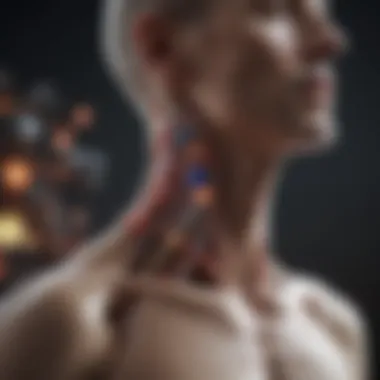Understanding Neck Cancer: Causes and Prevention


Intro
Neck cancer is a significant health concern, as it encompasses various malignancies in the head and neck regions. These cancers can impact the oral cavity, pharynx, larynx, and other nearby structures. Understanding how neck cancer develops is crucial for both prevention and treatment. This article will examine the mechanisms behind the onset of neck cancer, focusing on genetic, environmental, and lifestyle factors. The interplay of these factors contributes to the emergence of this complex disease.
Article Overview
Purpose of the Article
This article aims to provide an in-depth analysis of the initiation processes of neck cancer. By investigating the biological mechanisms that lead to tumor formation, we will shed light on the factors that increase the risk of developing this type of cancer. Emphasis will be placed on how genetic predispositions and lifestyle choices interact with environmental influences, forming a comprehensive view of neck cancer's onset.
Relevance to Multiple Disciplines
The subject of neck cancer from biological, medical, and public health perspectives offers valuable insights. Researchers can utilize this information to develop targeted therapies. Medical professionals can enhance their understanding of patient risks, leading to better screening and prevention strategies. Moreover, educators can use the findings to inform students of the multifaceted nature of cancer.
Research Background
Historical Context
Neck cancer has roots tracing back hundreds of years, with early descriptions of tumors in ancient medical texts. However, significant advancements in understanding its biological and environmental determinants emerged in the 20th century. The relationship between tobacco use and head and neck cancers was a pivotal discovery that shaped current prevention efforts.
Key Concepts and Definitions
It is essential to clarify several key concepts in the study of neck cancer:
- Malignancy: Refers to the presence of cancerous cells that can invade surrounding tissues.
- Tumorigenesis: This is the process through which normal cells transform into cancerous ones, involving genetic mutations and environmental triggers.
- Risk Factors: These encompass behaviors and exposures that increase the likelihood of developing cancer, which include smoking, heavy alcohol use, and certain viral infections.
Understanding these concepts lays the groundwork for an informed discussion of the mechanisms and risk factors associated with neck cancer.
Preamble to Neck Cancer
Neck cancer encompasses malignant growths located primarily in the head and neck regions, including the oral cavity, pharynx, and larynx. This form of cancer is not only critical from a medical standpoint but also holds substantial implications for public health. Understanding neck cancer is essential because it shows the interaction of genetic, environmental, and lifestyle factors in tumor development. Moreover, as this cancer type is prevalent in various demographics, acknowledging its onset and underlying mechanisms could help in prevention and early detection strategies.
Defining Neck Cancer
The term "neck cancer" broadly represents several potentially life-threatening cancers that occur in the interconnected regions of the head and neck. These include oropharyngeal cancer, laryngeal cancer, and thyroid cancer, each with unique characteristics.
Neck cancers generally arise from the squamous cells lining the mucosal surfaces in these areas. The stage of cancer can vastly influence treatment options, prognosis, and survival rates. Traditionally, they have been associated with high mortality rates if diagnosed at later stages. A precise understanding of what constitutes neck cancer enables better risk assessment and encourages proactive health measures.
Epidemiology and Prevalence
The epidemiology of neck cancer presents concerning statistics. Globally, neck cancers rank among the most common malignancies. In regions with high tobacco and alcohol consumption, such as Europe and parts of Asia, the prevalence rates are particularly alarming. According to the World Health Organization (WHO), head and neck cancers account for approximately 6% of all malignancies worldwide.
Factors affecting incidence rates include:
- Geographic location: Certain cancers show higher incidence in specific regions. For instance, HPV-related cancers are increasingly common in North America and Europe.
- Demographics: Age, gender, and ethnicity play crucial roles in prevalence. Men are generally more susceptible than women, and older adults face a higher risk.
- Risk factors: Smoking, heavy alcohol consumption, and HPV infection have all been demonstrated as significant contributing elements to the increasing rates of neck cancer.
"Understanding the epidemiology of neck cancer can lead to more effective public health interventions and targeted educational campaigns to reduce risk factors."
"Understanding the epidemiology of neck cancer can lead to more effective public health interventions and targeted educational campaigns to reduce risk factors."


In summary, gaining knowledge about neck cancer—its definition and prevalence—helps in framing a comprehensive strategy for research, public awareness, and effective healthcare resource allocation.
Understanding Cancer Biology
Understanding cancer biology is critical to grasp the complexities of neck cancer. It provides insights into how tumors develop over time. This section sheds light on fundamental processes that dictate cancer behavior. A comprehensive knowledge of cancer biology allows researchers and healthcare professionals to identify potential intervention points. This can lead to better prevention and treatment strategies.
Basic Cellular Processes
To understand cancer, one must first comprehend cellular processes. Cancer arises when normal cellular activities become dysregulated. Cell proliferation, apoptosis, and cellular differentiation are key processes.
- Cell Proliferation: This is the process where cells divide and multiply. In a healthy state, this process is tightly controlled. However, in cancer, this control can be lost, leading to uncontrolled growth.
- Apoptosis: Apoptosis is programmed cell death. Healthy cells undergo apoptosis when they are damaged or no longer needed. Cancer cells often evade this process, allowing them to survive longer than they should.
- Cellular Differentiation: This refers to cells developing specialized functions. Cancer can lead to a lack of differentiation, resulting in cells that do not perform their intended roles.
An intricate network of signals regulates these processes. Any disruption can contribute to cancer development. Understanding these cellular dynamics is therefore vital.
Genetic Mutations and Carcinogenesis
Genetic mutations play a significant role in the onset of cancer. They can lead to carcinogenesis. Carcinogenesis is the process where normal cells become cancerous. Genetic mutations may be inherited or acquired through environmental factors.
- Types of Mutations: Common mutations include point mutations, deletions, and insertions. Each can alter how cells function.
- Oncogenes and Tumor Suppressor Genes: Oncogenes promote cell growth. In contrast, tumor suppressor genes inhibit it. Mutations that activate oncogenes or inactivate tumor suppressor genes can lead to cancer.
- Epigenetic Changes: Besides genetic mutations, epigenetic modifications can affect gene expression. These changes do not alter the DNA sequence but can nonetheless influence cancer progression.
Understanding these genetic alterations is crucial for developing targeted therapies. These therapies may specifically address the underlying causes of cancer by correcting or inhibiting faulty genes.
Understanding these genetic alterations is crucial for developing targeted therapies. These therapies may specifically address the underlying causes of cancer by correcting or inhibiting faulty genes.
In summary, dissecting cancer biology paves the way for innovative research. By focusing on cellular processes and genetic mutations, we can develop effective strategies against neck cancer.
Risk Factors Associated with Neck Cancer
In the study of neck cancer, understanding the various risk factors is crucial. These factors contribute to the disease's onset and progression, providing insights into prevention and treatment. Evaluating risk factors can help individuals make informed lifestyle choices and assist healthcare professionals in identifying high-risk populations. Several elements play significant roles in neck cancer initiation, including tobacco use, alcohol consumption, HPV, environmental exposures, and chronic inflammation or infections.
Tobacco Use
Tobacco use is one of the primary risk factors for neck cancer. The carcinogenic compounds in tobacco can cause damage to the cells lining the mouth, throat, and other parts of the neck. Smokers are significantly more likely to develop cancers in these regions compared to non-smokers. Moreover, the risk increases with the duration and quantity of tobacco use. Even exposure to secondhand smoke can raise risk levels. Public health campaigns often emphasize quitting tobacco as a vital preventive measure.
Alcohol Consumption
Alcohol consumption is another notable risk factor. Heavy drinking, particularly when combined with tobacco use, dramatically increases the likelihood of developing neck cancer. The metabolite acetaldehyde, produced during alcohol digestion, can lead to cellular damage and mutations. Research indicates that individuals who consume alcohol in excess are at a much higher risk for these cancers. It is crucial for individuals to monitor their drinking habits and consider moderation as a strategy to mitigate this risk.
Human Papillomavirus (HPV)
Human papillomavirus, particularly HPV type 16, has emerged as a significant risk factor in neck cancer, specifically oropharyngeal cancers. This virus, commonly transmitted through sexual contact, can lead to specific cellular changes. The presence of HPV in the throat area has been associated with a distinct type of neck cancer that differs from those caused by traditional behaviors like smoking. Vaccination against HPV can serve as a preventive measure, highlighting the importance of awareness on this topic.
Environmental Exposure
Environmental exposure to various carcinogens also plays a role. Certain occupational hazards, including exposure to asbestos, wood dust, or chemicals used in industrial processes, can increase risk. Additionally, pollutants in the air and diet may contribute to the development of neck cancer. Understanding these exposures helps in crafting better environmental policies and creating safer workplaces.
Chronic Inflammation and Infection
Chronic inflammation, often resulting from long-term infections, can promote cancer development. For instance, long-lasting infections like chronic hepatitis or HIV can alter cellular processes. When paired with other risk factors, such as tobacco use, the likelihood of developing cancer rises significantly. Awareness of chronic infections and their potential link to cancer can foster early intervention methods, promoting better health outcomes.


In summary, recognizing and understanding the risk factors associated with neck cancer can play a pivotal role in prevention strategies and early detection. Public health efforts can greatly benefit from this knowledge, leading to improved health outcomes for at-risk populations.
In summary, recognizing and understanding the risk factors associated with neck cancer can play a pivotal role in prevention strategies and early detection. Public health efforts can greatly benefit from this knowledge, leading to improved health outcomes for at-risk populations.
The Pathogenesis of Neck Cancer
Understanding the pathogenesis of neck cancer is crucial for comprehending how various factors interplay to lead to malignant growth. The term pathogenesis encompasses the mechanisms through which normal cells transform into cancerous ones. This topic is particularly significant because it sheds light on the early events that can initiate cancer, as well as the processes that promote its progression. By identifying the elements involved in the development of neck cancer, researchers and healthcare professionals can devise better prevention and treatment strategies.
Initiation of Carcinogenesis
The initiation of carcinogenesis is a critical first step in the development of neck cancer. This phase refers to the genetic alterations that occur in normal cells, making them susceptible to malignant transformation. Several factors can instigate this process, including exposure to carcinogenic agents like tobacco and alcohol, which are prevalent in neck cancer patients.
- Genetic Mutations: Mutations in genes can activate oncogenes or deactivate tumor suppressor genes. For instance, mutations in the TP53 gene often occur in head and neck cancers, disrupting normal cell cycle regulation.
- Environmental Factors: Both physical and chemical agents in the environment can lead to DNA damage. UV radiation and certain chemicals found in industrial settings might serve as initiating factors.
- Viral Infections: Human Papillomavirus (HPV) is increasingly recognized as a major player in neck cancer initiation, particularly in oropharyngeal cases. HPV alters the cellular mechanisms, which may lead to uncontrolled cell division.
All these elements point towards a complex interplay of interactions. Therefore, a multifactorial approach is necessary to study this phase of tumorigenesis. Detection of these initiating events offers a crucial window for prevention and early intervention.
Promotion and Progression
Once initiation has occurred, the next phase in the pathogenesis of neck cancer is promotion and progression. During this stage, initiated cells proliferate in a conducive environment created by various factors that support tumor growth.
- Microenvironment Changes: The tumor microenvironment evolves with the introduction of inflammation, which may stem from chronic irritation due to tobacco or alcohol use. Immune cells in the area can promote tumor growth instead of inhibiting it.
- Influence of Lifestyle: Continued exposure to risk factors like smoking and high alcohol consumption not only keeps promoting the growth of initiated cells but also amplifies their malignant potential.
- Angiogenesis: Tumors often become dormant until they can orchestrate their blood supply. Neovascularization allows them to grow larger, fueling increased demands for nutrients and oxygen.
- Genetic Instability: The accumulation of further genetic changes during cell division enhances the malignancy of the tumor. This instability is a hallmark of cancer progression, making it increasingly difficult to combat.
Understanding this phase provides critical insights into how neck cancer advances and becomes more aggressive. Therefore, tackling both the initiation and promotion stages can offer valuable avenues for intervention.
Cellular Changes Leading to Neck Cancer
The onset of neck cancer involves a range of cellular changes that play a critical role in its development. Understanding these changes is essential for grasping the underlying mechanisms that contribute to the disease. Cellular alterations impact not just how cancer begins but also how it progresses and responds to treatment. Specific elements such as DNA damage, changes in cell signaling pathways, and the roles of tumor suppressor genes are pivotal in this narrative.
DNA Damage and Repair Mechanisms
DNA damage is a fundamental characteristic in the pathogenesis of neck cancer. The human body is constantly exposed to factors that can cause genetic mutations. This includes ultraviolet radiation, chemical agents, and also lifestyle choices such as tobacco and alcohol use. When DNA sustain damage, cellular mechanisms are activated to repair this harm.
However, the repair processes are not infallible. If the damage is extensive or if repair mechanisms fail, it can lead to mutations that disturb normal cell function. This uncontrolled genetic mutation may initiate the occurrence of cancer.
Key Points on DNA Damage and Repair:
- Types of DNA lesions: single or double-strand breaks, cross-links, etc.
- Repair pathways: Nucleotide excision repair, homologous recombination, and non-homologous end joining.
- Failure in repair mechanisms promotes genomic instability, facilitating cancer progression.
Alterations in Cell Signaling Pathways
In addition to DNA damage, alterations in cell signaling pathways are crucial in neck cancer development. Cells are constantly receiving signals from their environment that inform them when to grow, divide, or undergo apoptosis. Disruptions in these signals can result in uncontrolled cell growth and survival, hallmarks of cancer.
For instance, the activation of oncogenic pathways or the loss of pathways that promote cell death affects tumor behavior. These alterations can stem from mutations in receptor proteins or downstream signaling molecules.
Significant Pathways Impacted Include:
- The PI3K/Akt pathway: fostering cell survival and growth.
- The MAPK/ERK pathway: influencing cell proliferation.
- Wnt/β-catenin pathway: affecting cell adhesion and differentiation.
Role of Tumor Suppressor Genes and Oncogenes


The interaction between tumor suppressor genes and oncogenes is central to our understanding of neck cancer. Tumor suppressor genes such as p53 and RB typically act as safeguards against abnormal cell growth. When these genes become mutated or deleted, the regulatory mechanisms that usually control the cell cycle can be bypassed.
On the other hand, oncogenes are genes that have the potential to cause cancer when mutated or expressed at high levels. Examples include Ras and Myc. These genes often lead to persistent signaling for cell proliferation, contributing to tumor growth.
Understanding the balance between tumor suppressor genes and oncogenes is critical for developing targeted therapies in neck cancer treatment.
Understanding the balance between tumor suppressor genes and oncogenes is critical for developing targeted therapies in neck cancer treatment.
Finale
Identifying cellular changes leading to neck cancer helps form a clear picture of its onset. DNA damage and repair mechanisms, alterations in cell signaling pathways, and the roles of tumor suppressor genes and oncogenes contribute significantly to the cancerous transformation of neck cells. Continuous research is necessary to uncover how these processes can be manipulated for therapeutic benefits.
Preventive Measures and Strategies
Preventive measures and strategies are crucial in addressing neck cancer, a disease whose onset is closely linked to various modifiable risk factors. Understanding how to effectively reduce the incidence of this cancer involves both lifestyle changes and medical interventions. Prevention can mitigate risk, save lives, and decrease healthcare costs associated with treating advanced stages of the disease. Consequently, awareness of effective strategies plays a vital role in public health.
Lifestyle Modifications
Implementing lifestyle modifications can significantly reduce the risk of developing neck cancer. Research highlights several key changes that individuals can adopt:
- Quit Smoking: Tobacco use is one of the strongest risk factors for neck cancer. Quitting smoking reduces exposure to carcinogenic substances. Support programs and cessation aids can help individuals stop using tobacco.
- Limit Alcohol Intake: High alcohol consumption is a known risk factor. Limiting intake to moderate levels can greatly reduce cancer risk. Health guidelines recommend no more than one drink per day for women and two for men.
- Maintain a Healthy Diet: A diet rich in fruits, vegetables, and whole grains has been associated with a lower cancer risk. These foods contain antioxidants and essential nutrients that may help protect cells from damage.
- Stay Physically Active: Regular exercise is linked to a reduced risk of various cancers, including neck cancer. Physical activity helps maintain a healthy weight and supports overall well-being.
- Protect Against Sun Exposure: For cancers of the head and neck, minimizing sun exposure can reduce skin cancers in these areas. Wearing protective clothing and using sunscreen can aid in this preventive measure.
Making these lifestyle changes may require concerted effort and commitment, but the benefits far outweigh the challenges. Individuals must recognize the direct impact of their choices on their cancer risk and overall health.
Vaccination Against HPV
Vaccination against the human papillomavirus (HPV) is another essential preventative strategy. Certain strains of HPV are linked to an increased risk of neck cancer, particularly oropharyngeal cancers. The HPV vaccine has shown effectiveness in preventing infections that can lead to cervical and other HPV-related cancers.
- Target Group: The vaccination is most effective when administered to young people before the onset of sexual activity. The Centers for Disease Control and Prevention (CDC) recommend vaccination for preteens aged 11 to 12, though it can be given as early as 9.
- Vaccine Efficacy: Studies demonstrate that the vaccine dramatically reduces the prevalence of high-risk HPV strains among vaccinated populations. This contributes to lowering the incidence of related cancers in the long term.
- Awareness and Accessibility: Increased public awareness about the HPV vaccine can lead to higher vaccination rates. Education efforts should focus on dispelling myths about the vaccine and emphasizing its role in cancer prevention.
"Vaccination against HPV has transformed the landscape of preventive health, presenting an effective way to significantly reduce the risk of certain cancers, including neck cancer."
"Vaccination against HPV has transformed the landscape of preventive health, presenting an effective way to significantly reduce the risk of certain cancers, including neck cancer."
The End
The conclusion of this article is to bring together the intricate aspects discussed regarding neck cancer's onset, mechanisms, and risk factors. Understanding neck cancer is crucial not only for medical professionals but also for educators, students, and researchers who wish to grasp the complexities of this disease.
This section synthesizes key points, emphasizing the interplay between genetic predispositions, environmental influences, and lifestyle choices. The nuances explored herein highlight the multifaceted nature of neck cancer and underline the need for ongoing research.
"A comprehensive understanding of neck cancer's mechanisms is not just academic; it has real implications for prevention and treatment."
"A comprehensive understanding of neck cancer's mechanisms is not just academic; it has real implications for prevention and treatment."
Summary of Key Points
- Neck cancer arises from a combination of genetic, environmental, and lifestyle-related factors.
- Risk factors include tobacco use, alcohol consumption, and HPV infection, which contribute to disease initiation.
- The biological mechanisms involved include DNA damage, cell signaling pathway alterations, and disruptions in tumor suppressor genes.
- Preventive measures, such as lifestyle modifications and vaccination against HPV, can significantly reduce risk.
Future Directions in Research
Future research in neck cancer must focus on several crucial areas:
- Targeting Early Detection: Developing non-invasive methods for early diagnosis can improve treatment outcomes.
- Understanding Genetic Variability: More studies are needed to explore how genetic differences affect individual susceptibility to neck cancer.
- Innovative Therapeutics: Research into targeted therapies and immunotherapy may offer new hope in treating advanced stages of the disease.
- Longitudinal Studies: Examining how lifestyle changes impact neck cancer risk over time will provide valuable insights.
By pursuing these directions, researchers can contribute significantly to the knowledge base surrounding neck cancer, leading to enhanced prevention strategies and therapeutic approaches.



